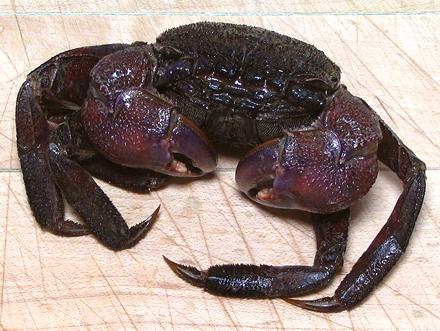 [Rice Field Crab, Black Crab; Boo Kem, Bpoo Kem (Thai, salted);
Ba Khía Nguyén Con (Vietnam, salted);
Somanniathelphusa species]
[Rice Field Crab, Black Crab; Boo Kem, Bpoo Kem (Thai, salted);
Ba Khía Nguyén Con (Vietnam, salted);
Somanniathelphusa species]
Rice paddies across Southeast Asia are often infested with these small freshwater crabs. They are considered pests as they eat young rice plants. They are hard to get rid of, because, when the paddies dry out, they tunnel into the mud and hibernate until the water comes back. Nonetheless, they are also an important commercial product, sold salt fermented whole, or ground into black crab paste. Both forms are used in Laos, Issan (northeastern Thailand) Vietnam and Cambodia, but unsalted crabs are also used, often fried whole, or ground up live for Bun Reiu Soup. The photo specimen (salted) was 1.7 inches across the carapace and weighed 1-7/8 ounces.
Mangrove crabs, about the same size, are an alternative, and will be free of parisites that are sometimes found in Paddy Crabs, but they are only available along the mangrove coasts.
More on Crabs.
These whole salted crabs and crab paste made from them are used in the famous Green Papaya Salad of Laos and Issan (northeast Thailand).
In Vietnam, fresh crabs are pounded to paste and strained, using the juice in a popular soup called Bún Rieu Cua. The crab juice is combined with pig blood, tamarind, rice vinegar, vegetables, seasonings and other ingredients. The residue is used to make crab cakes, which may also be used in the soup.